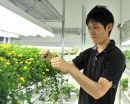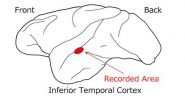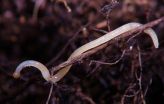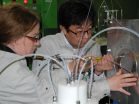(Press-News.org) Leguminous plants are able to grow well in infertile land, and bear many beans that are important to humans. The reason for this is because most legumes have a symbiotic relationship with bacteria, called rhizobia, that can fix nitrogen in the air and then supply the host plant with ammonia as a nutrient.
The plants create symbiotic organs called nodules in their roots. However, if too many root nodules are made it will adversely affect the growth of the plants, because the energy cost of maintaining excessive nodules is too large. Therefore legumes must have a mechanism to maintain the proper number of root nodules, but this system has been poorly understood.
Graduate Student Takema Sasaki and Professor Masayoshi Kawaguchi of the National Institute for Basic Biology, a member institute of the National Institutes of Natural Sciences, in collaboration with RIKEN, have shown that cytokinins, a kind of plant hormone, play an important role in preserving proper root nodule numbers using the model plant Lotus japonicus. The results of this work were published in the journal Nature Communications titled "Shoot-derived cytokinins systemically regulate root nodulation".
Previous research had shown that the number of nodules is not only controlled by the underground rhizobia-infected roots, but also that the leaves above the ground were deeply involved. Information signaling the current conditions of the root nodules is transported by glycopeptides from the roots to the leaves. On the other hand, while it was known that information was being fed-back to the roots from the leaves in order to control the number of root nodules, it was not known until now what substance carried these signals. The research group showed that cytokinins, produced in the leaves, are transported to the far away roots, and regulate root nodule formation there.
Mr. Sasaki explained "By examining 38 different internal hormones in plants, we were able to discover a new function of cytokinins". Professor Kawaguchi said "I never thought that the long-distance signaling molecules were going to be cytokinins. I think this research not only impacts our understanding of the symbiotic balance of rhizobia and legumes, but also has contributed greatly to the better understanding of plant hormones".
INFORMATION:
Long-distance communication from leaves to roots
2014-09-19
ELSE PRESS RELEASES FROM THIS DATE:
Lymphatic fluid used for first time to detect bovine paratuberculosis
2014-09-19
Paratuberculosis, also known as Johne's disease, is caused by the bacterium Mycobacterium avium subspecies paratuberculosis (MAP). In Austria, there is a legal obligation to report the disease. Paratuberculosis mainly affects ruminants and causes treatment-resistant diarrhoea and wasting among affected animals. The disease can cause considerable economic losses for commercial farms. The animals produce less milk, exhibit fertility problems and are more susceptible to other conditions such as udder inflammation.
To date there has been no treatment for paratuberculosis. ...
Neurons express 'gloss' using three perceptual parameters
2014-09-19
Japanese researchers showed monkeys a number of images representing various glosses and then they measured the responses of 39 neurons by using microelectrodes. They found that a specific population of neurons changed the intensities of the responses linearly according to either the contrast-of-highlight, sharpness-of-highlight, or brightness of the object. This shows that these 3 perceptual parameters are used as parameters when the brain recognizes a variety of glosses. They also found that different parameters are represented by different populations of neurons. This ...
Environmental pollutants make worms susceptible to cold
2014-09-19
Imagine you are a species which over thousands of years has adapted to the arctic cold, and then you get exposed to a substance that makes the cold dangerous for you.
This is happening to the small white worm Enchytraeus albidus, and the cold provoking substance, called nonylphenol, comes from the use of certain detergents, pesticides and cosmetics.
Nonylphenol is suspected of being a endocrine disruptor, but when entering the worm it has another dangerous effect: It inhibits the worm's ability to protect the cells in its body from cold damage.
Enchytraeus albidus ...
Quick-change materials break the silicon speed limit for computers
2014-09-19
The present size and speed limitations of computer processors and memory could be overcome by replacing silicon with 'phase-change materials' (PCMs), which are capable of reversibly switching between two structural phases with different electrical states – one crystalline and conducting and the other glassy and insulating – in billionths of a second.
Modelling and tests of PCM-based devices have shown that logic-processing operations can be performed in non-volatile memory cells using particular combinations of ultra-short voltage pulses, which is not possible with silicon-based ...
Milestone in chemical studies of superheavy elements
2014-09-19
An international collaboration led by research groups from Mainz and Darmstadt, Germany, has achieved the synthesis of a new class of chemical compounds for superheavy elements at the RIKEN Nishina Center for Accelerator-based Research (RNC) in Japan. For the first time, a chemical bond was established between a superheavy element – seaborgium (element 106) in the present study – and a carbon atom. Eighteen atoms of seaborgium were converted into seaborgium hexacarbonyl complexes, which include six carbon monoxide molecules bound to the seaborgium. Its gaseous properties ...
Technique to model infections shows why live vaccines may be most effective
2014-09-19
Vaccines against Salmonella that use a live, but weakened, form of the bacteria are more effective than those that use only dead fragments because of the particular way in which they stimulate the immune system, according to research from the University of Cambridge published today in the journal PLOS Pathogens.
The BBSRC-funded researchers used a new technique that they have developed where several populations of bacteria, each of which has been individually tagged with a unique DNA sequence, are administered to the same host (in this case, a mouse). This allows the ...
How pneumonia bacteria can compromise heart health
2014-09-19
Bacterial pneumonia in adults carries an elevated risk for adverse cardiac events (such as heart failure, arrhythmias, and heart attacks) that contribute substantially to mortality—but how the heart is compromised has been unclear. A study published on September 18th in PLOS Pathogens now demonstrates that Streptococcus pneumoniae, the bacterium responsible for most cases of bacterial pneumonia, can invade the heart and cause the death of heart muscle cells.
Carlos Orihuela, from the University of Texas Health Science Center in San Antonio, USA, and colleagues initially ...
Human sense of fairness evolved to favor long-term cooperation
2014-09-19
VIDEO:
This is a video describing the ultimatum game in chimpanzees.
Click here for more information.
ATLANTA—The human response to unfairness evolved in order to support long-term cooperation, according to a research team from Georgia State University and Emory University.
Fairness is a social ideal that cannot be measured, so to understand the evolution of fairness in humans, Dr. Sarah Brosnan of Georgia State's departments of Psychology and Philosophy, the Neuroscience Institute ...
Nuclear spins control current in plastic LED
2014-09-19
SALT LAKE CITY, Sept. 18, 2014 – University of Utah physicists read the subatomic "spins" in the centers or nuclei of hydrogen isotopes, and used the data to control current that powered light in a cheap, plastic LED – at room temperature and without strong magnetic fields.
The study – published in Friday's issue of the journal Science – brings physics a step closer to practical machines that work "spintronically" as well as electronically: superfast quantum computers, more compact data storage devices and plastic or organic light-emitting diodes, or OLEDs, more efficient ...
Changes in coastal upwelling linked to temporary declines in marine ecosystem
2014-09-19
In findings of relevance to both conservationists and the fishing industry, new research links short-term reductions in growth and reproduction of marine animals off the California Coast to increasing variability in the strength of coastal upwelling currents — currents which historically supply nutrients to the region's diverse ecosystem.
Along the west coast of North America, winds lift deep, nutrient-rich water into sunlit surface layers, fueling vast phytoplankton blooms that ultimately support fish, seabirds and marine mammals.
The new study, led by Bryan Black ...





